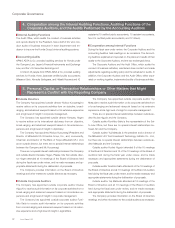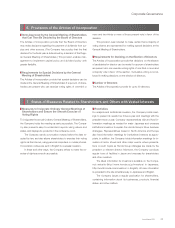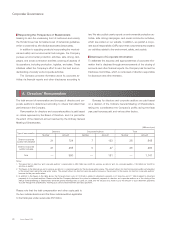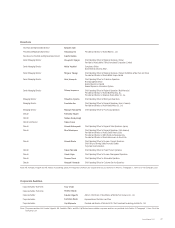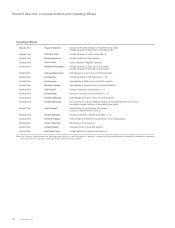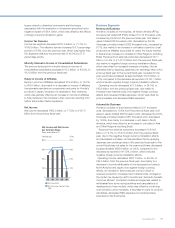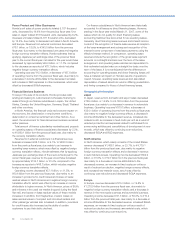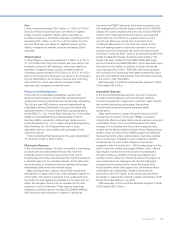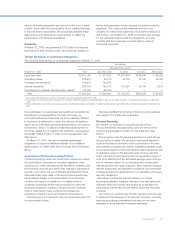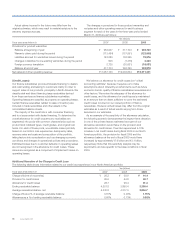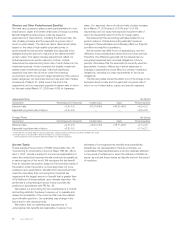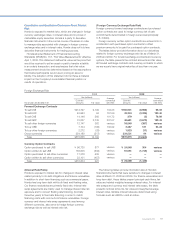Honda 2009 Annual Report Download - page 54
Download and view the complete annual report
Please find page 54 of the 2009 Honda annual report below. You can navigate through the pages in the report by either clicking on the pages listed below, or by using the keyword search tool below to find specific information within the annual report.
Power Product and Other Businesses
Honda’s unit sales of power products totaled 5,187 thousand
units, decreased by 14.4% from the previous fi scal year. Unit
sales in Japan totaled 516 thousand units, decreased by 6.2%.
Overseas unit sales totaled 4,671 thousand units, decreased
by 15.2%, due mainly to decreased unit sales in North America
and Europe. Revenue from external customers decreased
¥78.1 billion, or 18.5%, to ¥343.0 billion from the previous
fi scal year, due mainly to the decreased unit sales and negative
foreign currency translation effects. Honda estimates that by
applying Japanese yen exchange rates of the previous fi scal
year to the current fi scal year, net sales for the year would have
decreased by approximately ¥49.0 billion, or 11.7%, compared
to the decrease as reported of ¥78.1 billion, which includes
negative foreign currency translation effects.
Operating loss was ¥15.4 billion, a decrease of ¥37.8 billion
of operating income from the previous fi scal year, due mainly to
a decrease in income attributable to the decreased net sales
and increase in R&D expenses in other businesses, which was
offset by decreased SG&A expenses.
Financial Services Business
To support the sale of its products, Honda provides retail
lending and leasing to customers and wholesale fi nancing to
dealers through our fi nance subsidiaries in Japan, the United
States, Canada, the United Kingdom, Germany, Brazil, Thailand
and other countries.
In North America, the fi nancial crisis had a severe impact on
the economy, the deterioration in employment conditions,
deterioration in consumer sentiment and other factors. As a
result, the environment for fi nancial services business remained
under pressure.
Total amount of fi nance subsidiaries-receivables and property
on operating leases of fi nance subsidiaries decreased by 2.2%,
to ¥4,860.1 billion from the previous fi scal year, due mainly to
the currency translation effects.
Revenue from external customers in a fi nancial services
business increased ¥48.7 billion, or 9.1%, to ¥582.2 billion
from the previous fi scal year, due mainly to an increase in
operating lease revenue, which was offset by negative foreign
currency translation effects. Honda estimates that by applying
Japanese yen exchange rates of the previous fi scal year to the
current fi scal year, revenue for the year would have increased
by approximately ¥124.7 billion, or 23.4%, compared to the
increase as reported of ¥48.7 billion, which includes negative
foreign currency translation effects.
Operating income decreased ¥37.1 billion, or 31.5%, to
¥80.6 billion from the previous fi scal year, due mainly to an
increase in provisions for credit losses and losses on lease
residual values in North America and negative foreign currency
translation effects, which was offset by an increase in income
attributable to higher revenue. In North America, prices of SUVs
and minivans in the used car market dropped during the fi scal
fi rst half, and losses on lease residual values of these models
increased. In addition, from September onward, losses on
lease residual values of compact and mid-sized sedans and
other passenger vehicles also increased. In addition, provisions
for credit losses also increased as the ability of certain
customers to pay their debts declined.
Our fi nance subsidiaries in North America have historically
accounted for all leases as direct fi nancing leases. However,
starting in the fi scal year ended March 31, 2007, some of the
leases which do not qualify for direct fi nancing leases
accounting treatment are accounted for as operating leases.
Generally, direct fi nancing lease revenues and interest income
consist of the recognition of fi nance lease revenue at inception
of the lease arrangement and subsequent recognition of the
interest income component of total lease payments using the
effective interest method. In comparison, operating lease
revenues include the recognition of the gross lease payment
amounts on a straight line basis over the term of the lease
arrangement, and operating lease vehicles are depreciated to
their estimated residual value on a straight line basis over the
term of the lease. It is not anticipated that the differences in
accounting for operating leases and direct fi nancing leases will
have a material net impact on Honda’s results of operations
overall, however, operating lease revenues and associated
depreciation of leased assets do result in differing presentation
and timing compared to those of direct fi nancing leases.
Geographical Information
Japan
In Japan, revenue from domestic and export sales decreased
¥726.4 billion, or 14.9%, to ¥4,162.5 billion from the previous
fi scal year, due mainly to a decrease in revenue in automobile
business. Operating loss was ¥161.6 billion, a decrease of
¥354.1 billion of operating income from the previous fi scal year,
due mainly to negative foreign currency effects, a decrease in
income attributable to the decreased revenue, increased raw
material costs, an increase in fi xed costs per unit as a result of
reduced production and expenses related to withdrawal from
some racing activities and cancellations of development of new
models, which was offset by continuing cost reductions,
decreased SG&A and R&D expenses.
North America
In North America, which mainly consists of the United States,
revenue decreased ¥1,486.1 billion, or 23.7%, to ¥4,779.1
billion from the previous fi scal year, due mainly to negative
foreign currency translation effects and a decrease in revenue
in automobile business. Operating income decreased ¥352.9
billion, or 81.6%, to ¥79.7 billion from the previous fi scal year,
due mainly to a decrease in income attributable to the
decreased revenue, an increase in fi xed costs per unit as a
result of reduced production, negative foreign currency effects,
and increased raw material costs, which was offset by
continuing cost reductions and decreased SG&A expenses.
Europe
In Europe, revenue decreased ¥315.3 billion, or 19.8% to
¥1,278.9 billion from the previous fi scal year, due mainly to
negative foreign currency translation effects and a decrease in
revenue in the motorcycle business and automobile business.
Operating income decreased ¥41.3 billion, or 80.2%, to ¥10.2
billion from the previous fi scal year, due mainly to a decrease in
income attributable to the decreased revenue, increased SG&A
expenses, an increase in fi xed costs per unit as a result of
reduced production and increased raw material costs, which
was offset by continuing cost reductions.
Annual Report 2009
52


